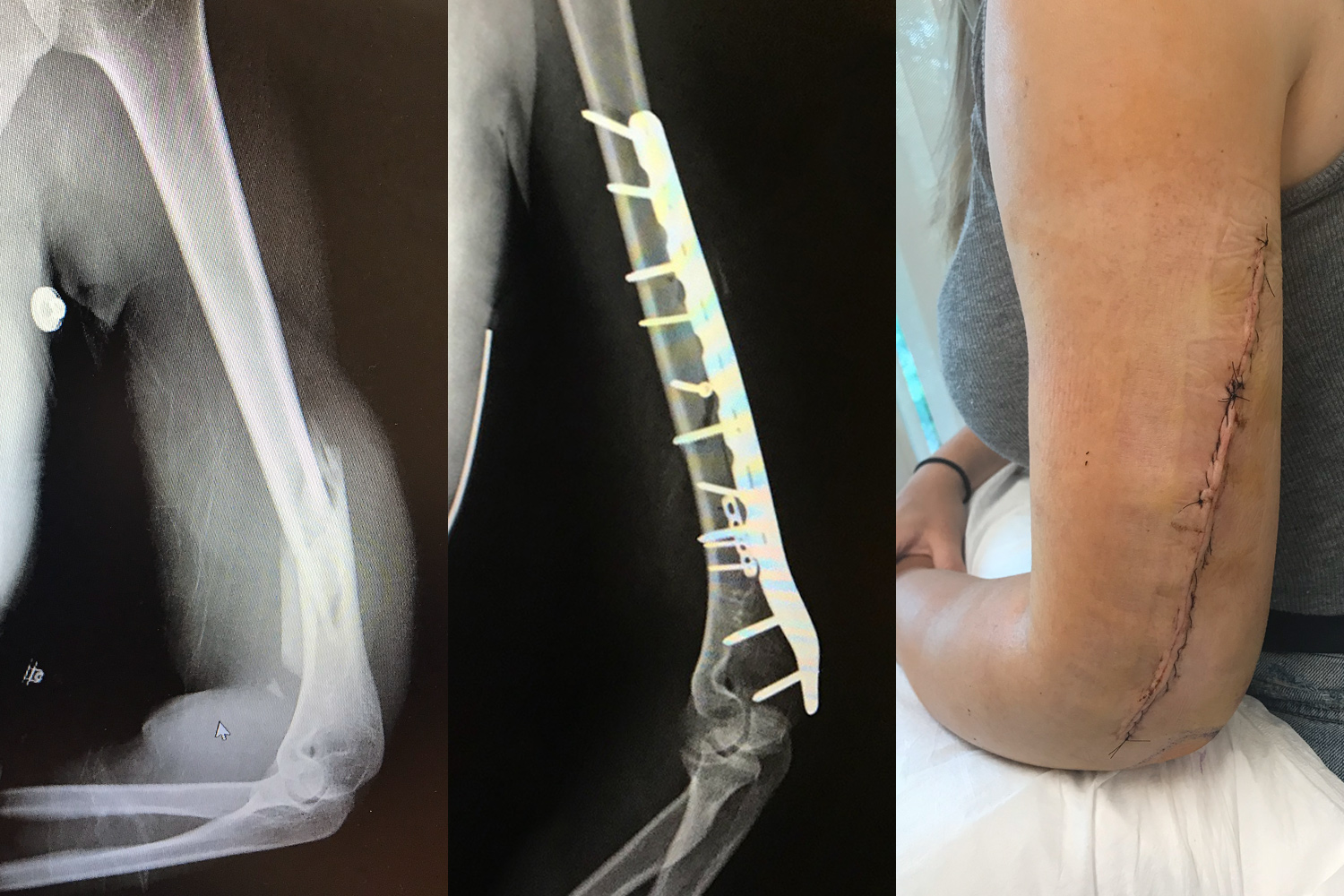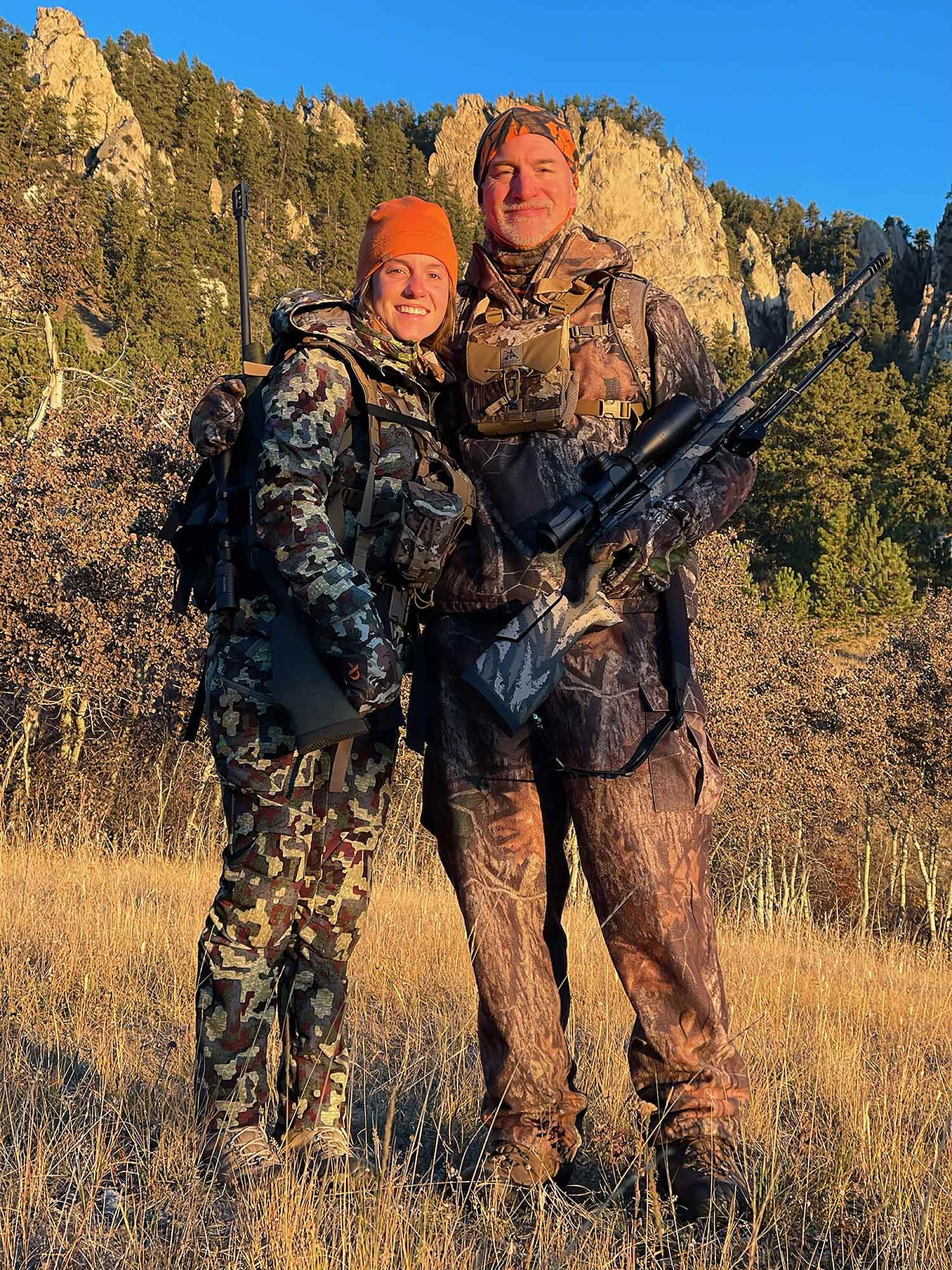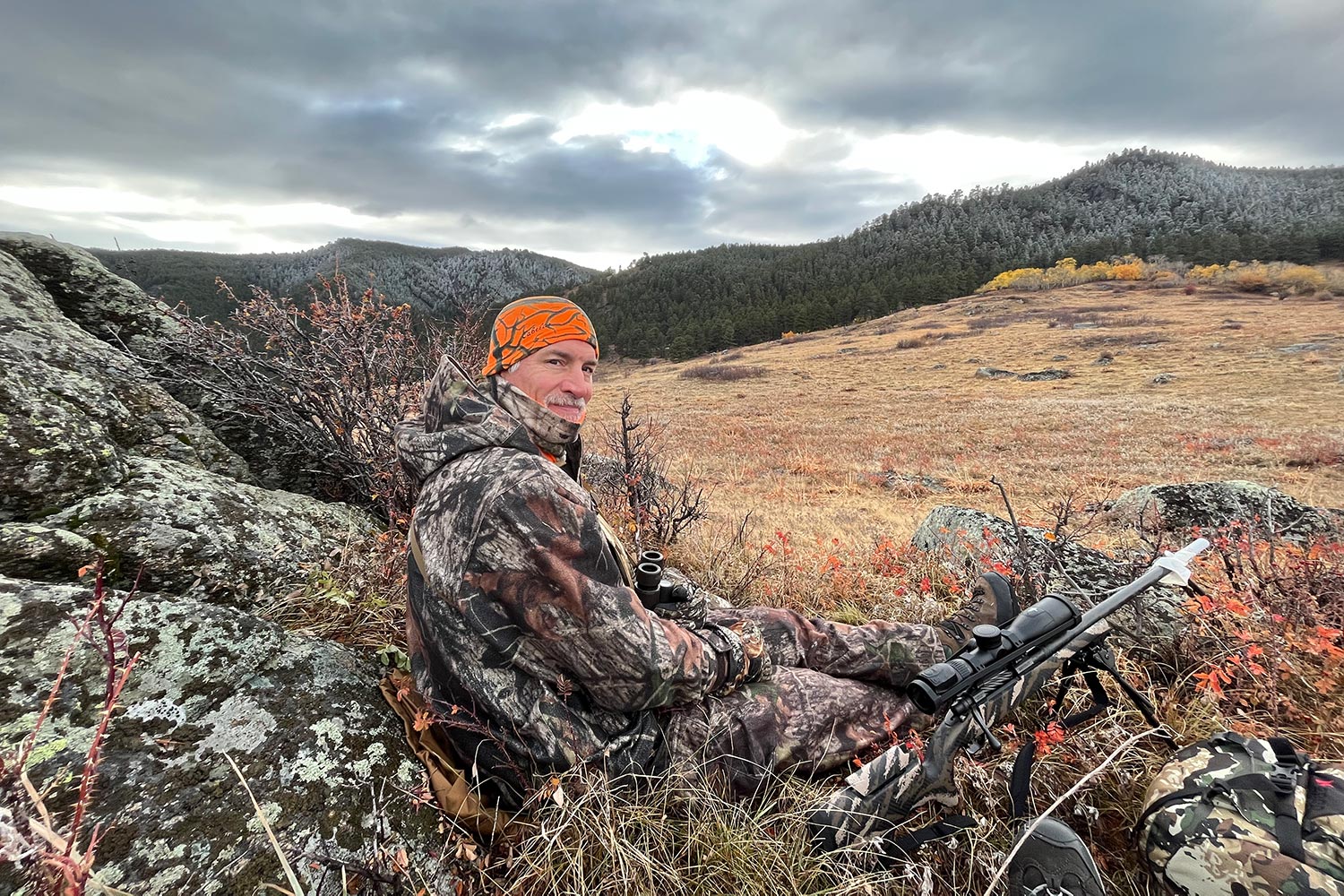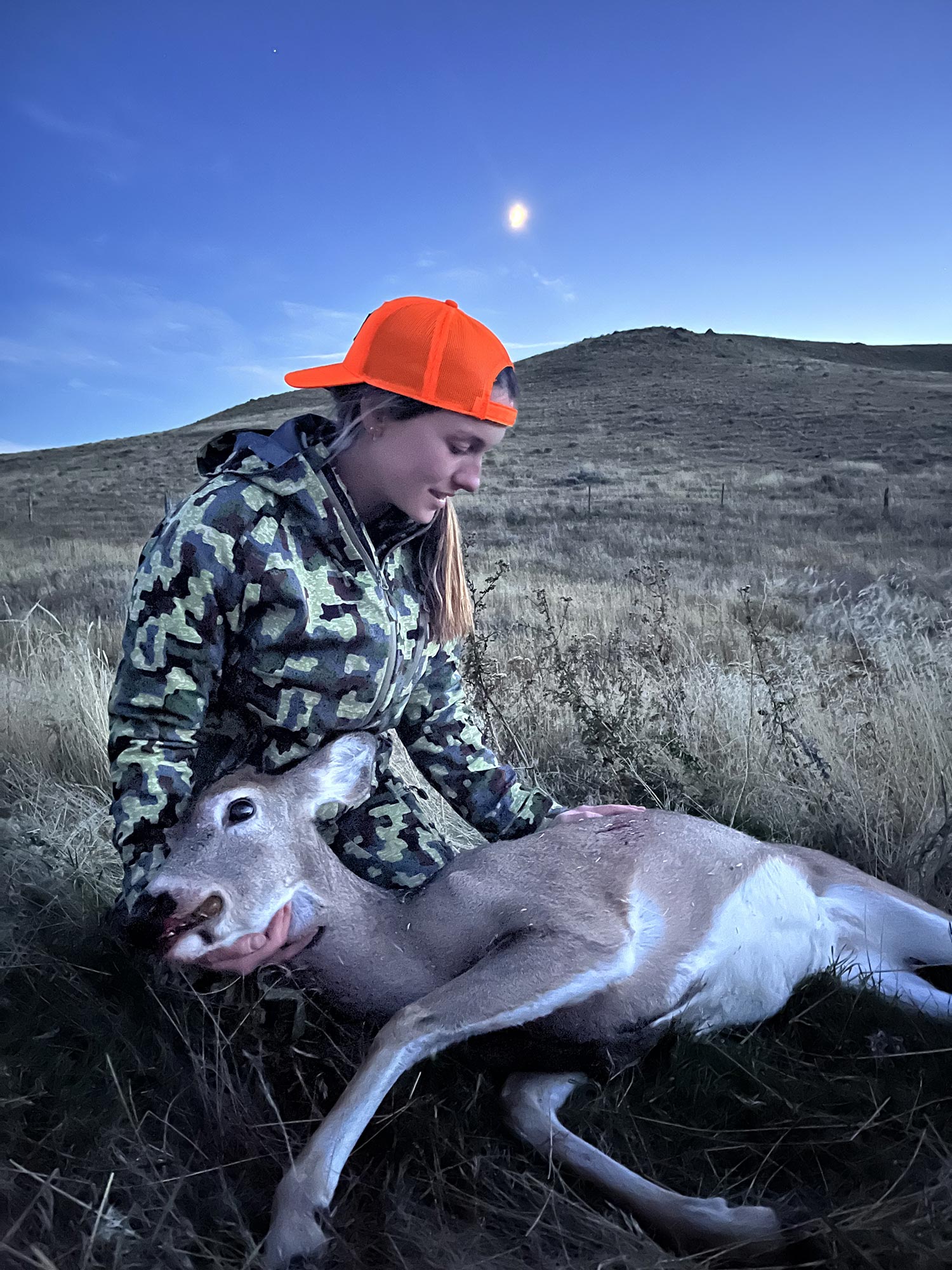I CAN SEE the pasture through my binoculars. Dry grass and dead clusters of arrowleaf balsamroot poke through patches of snow. Lichen-covered boulders litter the drainage, crumbs that tumbled down from the rock spires shooting out of the piney ridgeline above.
There is no “above treeline” in these foothills of Wyoming’s Bighorn Mountains. The pine forest starts around 6,400 feet and continues up until it crosses the national forest boundary, carpeting the closer peaks. The pasture itself has a lazy incline. It rises to a bare saddle between the timbered ridge on the west and a giant rocky outcropping to the east. My dad and I are on my first elk hunt here. We both have cow tags, but there’s not a cow in sight.
Dad’s been hunting elk on this ranch for a decade. I’ve been fortunate enough to tag along with him the past few years, learning from him, his hunting buddies, and guides who are more like extended family than anything else. My family took a vacation here when I was 11, and we’ve come back every summer since, like dive-bar regulars thirsty for a sagebrush buzz.
But I like this place better in the fall. It’s quieter and feels more like home. But as the midday temperatures of late October climb into the 60s and the elk retreat higher into the mountains than we’re prepared for, it becomes clear I’ll have to pivot if I want to put meat in my freezer.
I’m not exactly surprised. I’m intimately familiar with how nothing ever goes as planned out here.
A Broken Dream
This place fed my weird horse-girl tendencies from the moment I showed up. I would hang around the wranglers for the whole week, helping saddle horses in the mornings and afternoons, my persistence undoubtedly getting on their nerves. The summer I turned 19, I got a housekeeping job at the ranch.
The hours disappeared as I made beds, scrubbed toilets, and bent over a dish pit scraping crusty batter out of old muffin tins. I didn’t mind the work and was happy just to have my foot in the door. Still, I looked forward to the following summer, when my proverbial dues would be paid and my chances at becoming a wrangler would improve.
The jury’s still out on whether I was actually qualified for the job. I started riding before I could walk and stuck with it throughout my childhood. But I rode only in enclosed arenas under the watchful eyes of trainers and parents, a far cry from dashing through the mountains to help push a herd of 200 free-roaming horses toward the ranch’s corral.
I moved in for my second summer, my cowgirl summer, in late May. The first four days of work were marked by dead muscles, bruised knees, a blister on my ankle that left a scar, and promises from the other wranglers that I’d get used to it all. We went on the first big gather of the season, spending five hours herding horses from their winter range on the farthest reaches of the ranch’s thousands of acres. I survived, but I struggled. I knew I didn’t have the hang of it yet.
On my fifth morning, we rode up the pasture, then turned back to push grazing horses downhill. As I tried to fall in behind the other wranglers, my horse took off, dodging rocks at a full-tilt gallop. I tried to turn him uphill but lost my right stirrup in the process. As I shifted my weight left to compensate, the horse bolted right. If I were a saddle bronc rider, I would have barely made the eight before flying off the horse’s left side, hitting the ground face down, snapping my humerus, smashing my tibia against a rock, rolling downhill a few times, and coming to a stop with my face buried in a cluster of purple lupine.
I flew back East, where an orthopedic surgeon drilled 10 inches of titanium into my splintered bone and told me to start using my arm again as soon as I woke up. I had no feeling in a small patch on my lower leg where impact left minor nerve damage. It had taken less than a week for my dream job to reduce me to a worker’s compensation claim with an arm sling and an orange bottle of hydrocodone pills. It took a month to reteach my elbow how to bend and straighten, to wrestle the swollen joint into submission, to touch my own head and then my own face.

In late June, I returned to the ranch to bake desserts for up to 130 guests six days a week for the rest of that summer. The wranglers would clink into the kitchen in their spurs and sweaty pearl-snap shirts, forearms suntanned, boots dirty. On rainy days, they’d don leather chaps and long, oiled slickers, spraying water droplets around the staff dining room. I sat next to them in an apron caked with cocoa powder, jealousy and embarrassment silently tearing me to shreds.
Healing Wounds
I worked six days on, one day off. That day was usually spent hiking in the Bighorns, soaking in the landscape most of us didn’t grow up in but were drawn to anyway. As happy as I was to be back among my friends, partying and carrying on like an extra in Dirty Dancing, it was also painful to face this place again. I fought the urge to resent the horse and the land, and tried to take all the blame for what happened to me. After all, horse accidents are almost always caused by rider error.
But I also struggled with a constant, wrenching anger. The ranch had long been the idyllic backdrop to my silly dream of becoming a cowgirl. Then it forced me to humble myself and reckon with my limitations, sticking a pin in what could have started a life of adventure. Now I was just another college graduate destined for a desk job at summer’s end. But as far as my pride was concerned, returning to the ranch and sticking it out was my only option.

One day I decided to hike to the saddle above the drainage with a friend. I wandered off trail to the spot where I’d hit the ground just a few months prior. My scar burned in the heat. As we hiked on, I realized for the first time since my accident that I have good memories in that spot, too. One day, I woke up before sunrise in a sleeping bag on the porch of a small hunting cabin about 150 yards upslope. I waddled my bag into the tall grass to watch the sun rise over the basin below. As the sky got brighter, blushing purple and pink, I noticed movement on the other side of the drainage. Three mature 6×6 bulls emerged from the trees at a snail’s pace. Eventually, they made it to the bare saddle, the rising sun silhouetting them against the salmon sky.
My first ever elk sighting transformed my understanding of this land. It wasn’t just about trees and mountains and horses and wildflowers, or where I lost my job. This place held secret riches that required a closer look. I’d heard my dad’s elk hunting stories a thousand times, always envious that he got to come here twice a year. But this was the first time I ever thought seriously about joining him.
An Elk for Tom
Dad flashes a grin from across the truck bed as he tucks a small bottle into his pack. The label says “Canada Dry Soda Water” but the brown liquid sloshing around inside says otherwise. Back at the cabin, a bottle of Jack Daniels sits on the mantle above the fireplace with a pour missing. It’s for a toast after our hunt, when legal light has faded and we’re sitting on the truck tailgate again. In between is the part we’re both silently dreading: the evening sit on the 10-year anniversary of Dad’s first elk. That hunt hadn’t gone as planned, either.
I had been home with my mom and sister, waiting to hear from Dad. He’d told us earlier that he’d call once he was in for the night. We hadn’t heard from him yet, which meant he had more pressing tasks to tend to, like field dressing a deer and hanging it up in the old barn. But when the phone rang late that night, it wasn’t Dad. Mom answered the phone and gasped, suddenly choking on tears.

Dad called shortly after, breathless over a big-bodied raghorn, a deer hunter freshly hooked on elk. Mom congratulated him gently, trying to calm the mood before delivering the news that his best friend, a man his daughters called “uncle,” had died suddenly. None of us would remember Dad’s first elk as just that. It would forever be Tom’s bull, too.
Tonight, we set up about a half-mile west of the drainage, me in one clearing and Dad in another, hunting solo but certainly not alone. He spends the evening checking in with Uncle Tom across the divide of space and time until minutes after shooting light ends, when a mix of cows and bulls emerge inside 30 yards, grunting and bugling and dancing around each other. These are the first cows anyone has seen all week. Eventually he creeps away in the dark and joins the rest of us. He’s overwhelmed by it all.
On the ride back in, with our rifles unloaded and a sky seasoned with stars, Dad and I pass the whiskey back and forth. I haven’t drunk warm Jack Daniels since my third and final summer working out here, three years ago now. Not much had changed since then: not how the liquid lights a fire when it settles in my stomach, or how the land disappears under a moonless night, or Cassiopeia’s position in the Milky Way.
Belief in a higher power would dictate that tonight’s show was a gift to Dad, a cosmic commemoration of his friend’s passing. Belief in science would argue that the sun set, the air got colder, and the wind had favored his position. Hunting seems to sit where those two belief systems overlap.

Tangible, earthly things like fur and blood and bone take on more meaning during a hunt than when we stumble across a carcass on a hike, knowing there’s a mountain lion with a full belly somewhere nearby. That is biology and ecology playing out in front of us. So far, dealing death myself doesn’t feel great in my soul, even if it does feel oddly natural and correct in some primitive recess of my brain. I like to think most hunters cherish living animals as much as they do dead ones, if not more so. Dad was so content to sit there and watch elk without an ounce of frustration that they came out when they did, just after shooting light faded away.
Maybe we’re all wired to think that way, to take the perfect with the imperfect, the spiritual with the harsh truth. Dad actively chooses to remember the many good times with Tom, even though sadness and pain seeps in. By the same token, watching animals live and breathe is the one inevitable part of killing and eating them, and climbing on a horse means eventually coming off, sometimes by force rather than by choice. But people live, hunt, and ride every day anyway.
A New Lesson
Dad tags a nice whitetail buck a few days later. We don’t see another elk all week. On the last night of the hunt, I find myself glassing up the pasture again. The view is a familiar one, but I’ve never stared at it the way I do now, through binoculars with a loaded .308 at my side. My own cow elk tag burns in my pocket, and the air feels a little colder than it did a few days ago when I drove into town to buy a doe tag, hedging my bets against the weather and a shocking absence of cows.
If I were thinking like an experienced hunter, I would have listened to my guide, Justin, and returned to the low-lying field near the dairy barn where I tagged my first whitetail doe last year. But I wanted to go to the drainage, where I have unfinished business. Besides, things happen here. They may not always be happy, but I can always rely on that spot where the pines transition into a gentle, brushy slope to produce some sort of action.
I hope for the perfect full-circle moment as I scan the treeline for a patch of hide or flick of a tail. The way it plays out in my head, I take a perfect shot from an impressive but responsible distance, accomplishing something in the same place where I once felt useless. This would mend my relationship with the drainage, giving me a new memory to see when I look at the familiar landscape, adding to the ever-growing web of experiences connecting me to this exact spot.
Except the first critters I see are in the opposite direction, two draws away.
“Whitetails,” I hiss from behind my binoculars. Justin quickly picks up the group of six at 800 yards.

I glass up my drainage again, empty and motionless. Light fades by the minute. Justin asks me what I want to do. I think of Dad’s buck hanging in the barn. He honored the past for one evening sit, and then had success when he was back in the present. I’d been living in the past all week and my time to move on is running out. I turn around and look at the deer again, snapping out of the sentimental trance. We pack up and hike back down the drainage, racing against shooting light and shifting winds.
I wasn’t a hunter when I had my accident, nor when I sat down at a tattoo shop in Boston the following winter. The artist decorated my 10-inch scar with the pasture drawn in thin, black lines, contained in a galloping horse. At the time, I missed Wyoming and felt the need to keep that spot close to me. I had no clue that when it came to connecting with a landscape, a hunt could do the work of a thousand small tattoos.
I’m still trying to figure out what role hunting will play in my life, and why it’s something that I feel so drawn to after just a few hunts and two notched doe tags. I’m pretty sure it’s at least partially about the memories and traditions and deepening connections with the land, dancing between science and the spirit. But I think it’s also about moving past all that and grabbing the reality that’s right in front of you. That’s a lesson worth chasing on a runaway horse.
But for once, I’m not thinking about horses right now. Instead, I have a beautiful doe to field dress, and my shot wasn’t perfect. Justin stands uphill, holding her front legs and giving me step-by-step instructions on what to do. I work away at the mess of a pulverized liver and digestive tract while the warm pool of blood steams under the light of our headlamps. After we finish, I drag the carcass across the rutted ground toward the truck, tripping and laughing at myself and crying at all of it, wondering how many more lessons in imperfection I have yet to learn from this place.
Read more OL+ stories.
